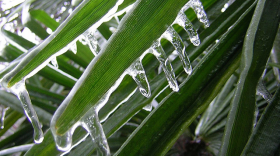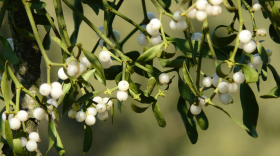Dr. Jerry Jackson
-
Blue crabs are familiar to most beach goers because of the telltale blue on their legs – and to most seafood aficionados because of their luscious taste and prominence on seafood menus. While they are found over a wide span of warm near-shore seawaters, they are particularly abundant in Florida. On this week’s “Wild Things” I’ll focus on their seasonal movements, their longevity, their mating behavior, their swimming abilities, and the rapidity with which they can hide from a predator by backing into soft sand or mud to escape a potential predator.
-
The Loggerhead Shrike is found in Florida year-round, but reaches its peak abundance in mid-winter with the arrival of more-northern migrant birds.Shrikes feed extensively on insects, small mammals, birds, reptiles and other prey that they capture on or near the ground. As snow begins to cover the ground to the north, shrikes head south – joining the human “snowbirds” and our resident non-migratory population of shrikes.Little is known of interactions between the migrant and the resident shrike populations – providing a difficult, probably long-term, research opportunity. Both resident and migrant shrikes occupy open habitats both in cities and in the country-side.Roadsides with close-cropped vegetation and bordering fences are favored sites because of the presence of road-killed or injured animals and the ease of seeing animals crossing the road.Their flight in pursuit of prey is often within 3-4 feet of the ground. This, of course also makes shrikes vulnerable to getting hit on the road. Thus far Loggerhead Shrikes remain across their continent-wide range, but they also remain very vulnerable.
-
Pigeons and Doves are members of the same family – Columbidae – and the names “pigeon” and “dove” have little relevance. Those we call “pigeons” are generally larger than those we call doves. Pigeons and doves occur on every continent and many islands and about 300 living species of pigeons and doves are known.Seven species are regularly found in Florida -- five are native; two are introduced. Others are occasionally seen. One – the Passenger Pigeon – was known from Florida, but now extinct.
-
Animals in south Florida don’t have to worry much about winter cold – and indeed many migrants from areas farther north find suitable living conditions here. But, a trip to the beach or on a rare blustery day sometimes makes one wonder. How do ducks, herons, egrets, and other birds tolerate wading or swimming in cold weather? Aquatic birds, for example, have bare skinny legs with leg muscles placed among insulating feathers.Blood vessels going to and from the very few muscles in the legs and feet lie right next to one another, and cold blood going back into the body is warmed by warmer blood coming from the body – and is nearly the same temperature as the blood circulating in the well-insulated body.
-
-
If asked “What plant best symbolizes the winter season?”, most people might say “Christmas trees”, but a fair number might instead suggest holly. Several species of holly are native to North America. Most are evergreen, have thick, somewhat shiny leaves that are resistant to colder climates, and are bordered and tipped with sharp points that protect the leaves from winter plant “munchers”, and in winter bear small red fruits that add to their winter holiday appeal. The fruits are eaten by many bird species and the seeds inside the fruits are deposited with a bit of fertilizer to begin growth in the spring. Some holly species grow into large trees.
-
New World Warblers are often referred to as the “butterflies of the bird world” – a designation because of their small size and diverse colors and patterns. A few warblers nest in south Florida, but several -- including the Palm Warbler, Yellow-rumped Warbler, and Black-and-white Warbler are common winter residents.These three have distinctive plumage patterns and behaviors, making them a great trio to begin exploring the diversity of warblers that pass through on migration. Beware, however: watching warblers as they flit among the branches of tall trees in search of insects can be addictive – and lead to a temporary affliction commonly known among birders as “warbler neck”.
-
Little Blue Herons are medium in size among herons – bigger than a Green Heron, but much smaller than a Great Blue Heron. The “blue color” of adults often tends towards gray and it helps them blend in with their aquatic environment. This heron is unusual in that its juvenile plumage is all white – a characteristic that allows it to blend in with other white birds – which it readily does, thus gaining “group” protection from potential predators and access to food resources found by the other species. Adults are much more solitary.
-
Wild Turkeys are birds that most of us know on sight because of their large size, habit of foraging in groups in relatively open areas, and the display of a male with his tail held up and fanned. Of course we know them because of their prominence at our holiday dinner tables – and in holiday advertising -- especially at Thanksgiving.
-
Molt is defined as the routine loss and replacement of feathers. It can occur at any time of year, but in most birds a complete molt occurs in late summer and fall and a partial molt may occur in early spring.The timing of each molt is important. In late summer and fall, there is generally an abundance of insects, seeds, and fruit that provides the energy for molt. This molt provides birds with fresh plumage and often colors and patterns that help conceal it in winter environments.










